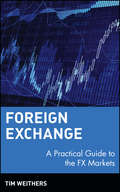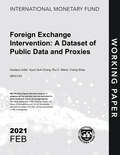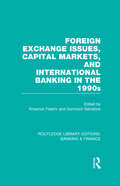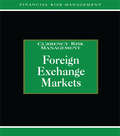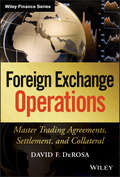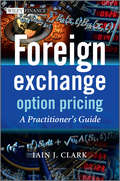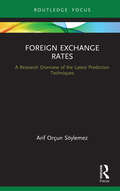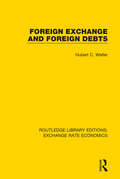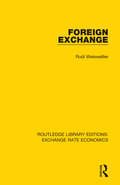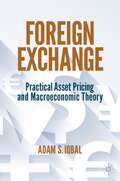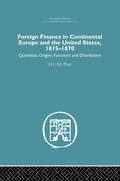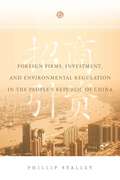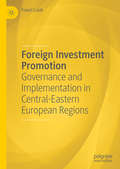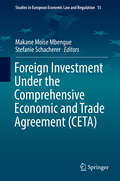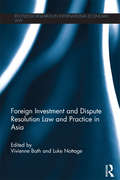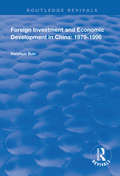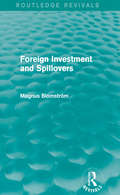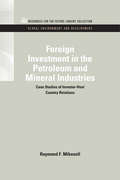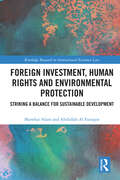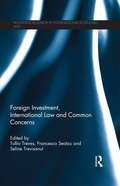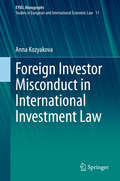- Table View
- List View
Foreign Exchange
by Tim WeithersPraise for Foreign Exchange"Tim Weithers starts by telling the reader that foreign exchange is not difficult, just confusing, but Foreign Exchange: A Practical Guide to the FX Markets proves that money is much more exciting than anything it buys. This useful book is a whirlwind tour of the world's largest market, and the tour guide is an expert storyteller, inserting numerous fascinating insights and quirky facts throughout the book."-John R. Taylor, Chairman, CEO and CIO, FX Concepts"The book reflects the author's doctorate from the University of Chicago, several years' experience as an economics professor, and, most recently, a very successful decade as an executive at a huge international bank. These fundamental ingredients are seasoned with bits of wisdom and experience. What results is a very tasty intellectual stew."-Professor Jack Clark Francis, PhD, Professor of Economics and Finance, Bernard Baruch College"In this book, Tim Weithers clearly explains a very complicated subject. Foreign Exchange is full of jargon and conventions that make it very hard for non-professionals to gain a good understanding. Weither's book is a must for any student or professional who wants to learn the secrets of FX."-Niels O. Nygaard, Director of Financial Mathematics, The University of Chicago"An excellent text for students and practitioners who want to become acquainted with the arcane world of the foreign exchange market."-David DeRosa, PhD, founder, DeRosa Research and Trading, Inc., and Adjunct Professor of Finance, Yale School of Management"Tim Weithers provides a superb introduction to the arcana of foreign exchange markets. While primarily intended for practitioners, the book would be a valuable introduction for students with some knowledge of economics. The text is exceptionally clear with numeric examples and exercises that reinforce concepts. Frequent references are made to the economic theory behind the trading practices."-John F. O'Connell, Professor of Economics, College of the Holy Cross
Foreign Exchange Hedging Strategies at General Motors
by Mihir A. Desai Mark F. VeblenHow should a multinational firm manage foreign exchange exposures? Examines transactional, translational, and competitive exposures. Describes General Motors' corporate hedging policies, its risk management structure, and how accounting rules impact hedging decisions. Although the overall corporate hedging policy provides a consistent approach to the foreign exchange risks that General Motors must manage, there are situations where the company must consider deviations from prescribed policies. Describes three such situations: large exposure to the Canadian dollar with adverse accounting consequences, GM's exposure to the Argentinean currency when devaluation is widely anticipated, and the impact of the depreciation of the Japanese yen to the dollar. To obtain executable spreadsheets (courseware), please contact our Customer Service Department at custserv@hbsp.harvard.edu
Foreign Exchange Hedging Strategies at General Motors: Competitive Exposures
by Mihir A. Desai Mark F. VeblenHow can a multinational firm analyze and manage currency risks that arise from competitive exposures? General Motors has a substantial competitive exposure to the Japanese yen. Although the risks GM faces from the depreciating yen are widely acknowledged, the company's corporate hedging policy does not provide any guidelines on managing such competitive exposures. Eric Feldstein, treasurer and vice-president of finance, has to quantify GM's yen exposure and recommend a way for GM to manage the risks that arise from its competitive exposure. Students must analyze the impact of a yen depreciation on GM sales and profits. A rewritten version of an earlier case.
Foreign Exchange Hedging Strategies at General Motors: Transactional and Translational Exposures
by Mihir A. Desai Mark F. VeblenHow should a multinational firm manage foreign exchange exposures? Examines transactional and translational exposures and alternative responses to these exposures by analyzing two specific hedging decisions by General Motors. Describes General Motors' corporate hedging policies, its risk management structure, and how accounting rules impact hedging decisions. Although the overall corporate hedging policy provides a consistent approach to the foreign exchange risks that General Motors must manage, the company also has to consider deviations from prescribed policies. Describes two such situations: a significant exposure to the Canadian dollar with adverse accounting consequences and GM's exposure to the Argentinean currency when devaluation is widely anticipated. Students must evaluate the risks General Motors faces in each situation and consider which hedging strategy--if any--might be appropriate. Additionally, asks students to analyze the financial costs and accounting treatment of alternative derivative transactions for hedging purposes. A rewritten version of an earlier case.
Foreign Exchange Intervention: A Dataset of Public Data and Proxies (Imf Working Papers)
by ShaoA report from the International Monetary Fund.
Foreign Exchange Issues, Capital Markets and International Banking in the 1990s (Routledge Library Editions: Banking & Finance)
by Dominick Salvatore Khosrow FatemiThe need for continued analysis and evaluation of the international financial system is as pressing now as it was when this book was originally published. This volume provides an in-depth analysis of certain aspects of the international financial system. Specifically it addresses four of the most important financial and monetary issues of the present time: exchange rate, capital markets, international banking and external debt and international financial management.
Foreign Exchange Markets and Transactions
by Mihir A. Desai Kathleen Luchs Yanjun Wang Christina B. PhamProvides information on the foreign exchange market and exchange rate movements. Describes the different types of foreign exchange transactions, including spot transactions, forwards, swaps, futures, and options. Includes worked examples to help students understand the different instruments and an appendix with additional exercises. A rewritten version of an earlier note.
Foreign Exchange Markets: Currency Risk Management (Glenlake Series in Risk Management)
by Brian CoyleFirst Published in 2001. Routledge is an imprint of Taylor & Francis, an informa company.
Foreign Exchange Operations
by David F. DerosaThe ultimate nuts-and-bolts guide to foreign exchange operationsThe foreign exchange landscape is particularly risky since so much of the world is unregulated and takes place over the counter (off exchange). Brilliant traders and money managers who are profitable may find themselves underperforming, or worse, losing, simply because they failed to establish strong operations. In this book, David DeRosa provides industry players with everything they need for strong operational functions from all the types of trades to execution, master trading agreements, documentation, settlement, margin and collateral, and prime brokerage services.Contains vital work flow solutions for trading in the volatile foreign exchange marketplace Offers information for mastering the operational aspect of foreign exchange trading to help determine best partners such as prime brokers and othersWritten by David DeRosa a leading foreign exchange expert who has consulted to hundreds of financial institutionsForeign Exchange Operations helps traders mitigate risks and offers a guide to all aspects of trading operations from mastering trading agreements to margin documentation.
Foreign Exchange Option Pricing
by Iain J. ClarkThis book covers foreign exchange options from the point of view of the finance practitioner. It contains everything a quant or trader working in a bank or hedge fund would need to know about the mathematics of foreign exchange--not just the theoretical mathematics covered in other books but also comprehensive coverage of implementation, pricing and calibration. With content developed with input from traders and with examples using real-world data, this book introduces many of the more commonly requested products from FX options trading desks, together with the models that capture the risk characteristics necessary to price these products accurately. Crucially, this book describes the numerical methods required for calibration of these models - an area often neglected in the literature, which is nevertheless of paramount importance in practice. Thorough treatment is given in one unified text to the following features:Correct market conventions for FX volatility surface constructionAdjustment for settlement and delayed delivery of optionsPricing of vanillas and barrier options under the volatility smileBarrier bending for limiting barrier discontinuity risk near expiryIndustry strength partial differential equations in one and several spatial variables using finite differences on nonuniform gridsFourier transform methods for pricing European options using characteristic functionsStochastic and local volatility models, and a mixed stochastic/local volatility modelThree-factor long-dated FX modelNumerical calibration techniques for all the models in this workThe augmented state variable approach for pricing strongly path-dependent options using either partial differential equations or Monte Carlo simulationConnecting mathematically rigorous theory with practice, this is the essential guide to foreign exchange options in the context of the real financial marketplace.Table of ContentsMathematical Preliminaries Deltas and Market ConventionsVolatility Surface ConstructionLocal Volatility and Implied VolatilityStochastic VolatilityNumerical Methods for Pricing and CalibrationFirst Generation Exotics - Binary and Barrier OptionsSecond Generation ExoticsMulticurrency OptionsLong-dated FX Options
Foreign Exchange Rates: A Research Overview of the Latest Prediction Techniques (Routledge Focus on Economics and Finance)
by Arif Orçun SöylemezPredicting foreign exchange rates has presented a long-standing challenge for economists. However, the recent advances in computational techniques, statistical methods, newer datasets on emerging market currencies, etc., offer some hope. While we are still unable to beat a driftless random walk model, there has been serious progress in the field. This book provides an in-depth assessment of the use of novel statistical approaches and machine learning tools in predicting foreign exchange rate movement. First, it offers a historical account of how exchange rate regimes have evolved over time, which is critical to understanding turning points in a historical time series. It then presents an overview of the previous attempts at modeling exchange rates, and how different methods fared during this process. At the core sections of the book, the author examines the time series characteristics of exchange rates and how contemporary statistics and machine learning can be useful in improving predictive power, compared to previous methods used. Exchange rate determination is an active research area, and this book will appeal to graduate-level students of international economics, international finance, open economy macroeconomics, and management. The book is written in a clear, engaging, and straightforward way, and will greatly improve access to this much-needed knowledge in the field.
Foreign Exchange and Foreign Debts (Routledge Library Editions: Exchange Rate Economics)
by Hubert C. WalterOriginally published in 1926. This book explains clearly the depreciation of the franc, the return to the gold standard and dollar parity, inflation and deflation, the stabilization of the mark and its effects; and the connexion between exchange rates and prices. It describes the transfer of money abroad, bank credits, the various methods in which documentary bills are dealt with and foreign currencies exchanged. Based on the author’s practical experience of finance, it incorporates economic research and contains a concise statement of Britain’s debt to America, the Dawes Reparation Plan, and the debt settlements with France and Italy.
Foreign Exchange: A Manual Of Effective Practice (Routledge Library Editions: Exchange Rate Economics #12)
by Rudi WeisweillerOriginally published in 1972. This book covers the broader aspects of foreign exchange, for businessmen, to remove a hazardous gap in executive knowledge. The language is non-technical and the author gives an insight into the workings of the international currency markets which will enable business-men to operate more easily and be more profitable in this field.
Foreign Exchange: Practical Asset Pricing and Macroeconomic Theory
by Adam S. IqbalOne of the great challenges that many participants in foreign exchange (FX) markets face is sifting through the often overwhelming amount of information that is available. Media outlets stream updates on international politics, economics, and other factors that move FX prices twenty-four hours a day. It is difficult to work out what is and what is not important. This book helps its reader overcome these challenges by combining the insights gained from a market practitioner who has traded FX at Goldman Sachs, PIMCO, and Barclays Investment Bank, with textbook-level modern financial macroeconomic theory. The book covers macroeconomics relating to exchange rate determination. While you could obtain this information from a disparate set of sources―textbooks, academic literature, industry research notes, conversations with other market practitioners, and theories cited in media reports―this book brings all of these sources together to translate the information into concrete FX views that are firmly rooted in the macroeconomic theory of risk premiums, interest rates, and inflation, among other topics. The book promotes time consistent thought that avoids the daily temptation to jump from that day’s economic narrative to the next. Of particular interest to buy- and sell-side industry practitioners, finance and economics graduate students, academics, and others interested in FX markets, this book teaches its readers how to do this and improve their own trading and understanding of the FX markets.
Foreign Finance in Continental Europe and the United States 1815-1870: Quantities, Origins, Functions and Distribution
by D.C.M. PlattFirst Published in 2005. Routledge is an imprint of Taylor & Francis, an informa company.
Foreign Firms, Investment, and Environmental Regulation in the People's Republic of China
by Phillip StalleyThis new book takes as its focus a simple yet critical question: Does foreign direct investment lead to weakened environmental regulation, thereby turning developing countries into "pollution havens"? The debate over this question has never before been the focus of a book about China. Phillip Stalley examines the development of Chinese law governing the environmental impact of foreign investors, describes how regional competition for investment has influenced environmental regulation, and analyzes the environmental practices of foreign and Chinese companies. He finds only modest evidence that integration with the global economy has transformed China into a pollution haven. Indeed, after China opened its domestic market, the entry of foreign films largely strengthened the environmental protection regime, including the oversight of foreign firms' environmental practices. Nevertheless, foreign firms (and the competition to lure them) have posed new challenges to controlling industrial pollution. Stalley identifies the conditions under which foreign investment contributes to and undermines environmental protection, offering readers a solid understanding of China's environmental challenges. He also builds on existing theory and provides hypotheses that can be tested with other developing nations.
Foreign Investment Promotion: Governance and Implementation in Central-Eastern European Regions
by Paweł CapikAnalysing foreign investment promotion at a regional level in the Czech Republic, Poland and Slovakia, the book applies regional science, international business, and place marketing concepts to explore how Central Eastern European Countries compete for multinational firms. Taking a multidisciplinary approach, the author places special emphasis on promotion and its role within a wider context of regional strategies aimed at inward investment attraction. With useful insights for policy-makers, the book combines theory with empirical evidence and provides valuable reading for those researching international business location, place marketing and regional development.
Foreign Investment Under the Comprehensive Economic and Trade Agreement (Studies in European Economic Law and Regulation #15)
by Makane Moïse Mbengue Stefanie SchachererThis book analyzes the investment chapter of a new type of trade agreement between Canada and the European Union to help readers gain a better understanding of this mega-regional deal, which includes foreign investment protection. It first provides background information on the Comprehensive Economic and Trade Agreement (CETA), particularly focusing on the chapter on foreign investment, including the rules on the entry of investments, their protection and the stringent dispute settlement mechanism. It goes on to explore whether these provisions are a further step toward reforming the current international investment law regime. It also examines the highly innovative part of the agreement: the inclusion of crosscutting issues, such as sustainable development. In addition, it examines the CETA investment chapter from the perspective of non-contracting parties, including Africa, Asia and Latin America. The book is of interest to academics and students in the field of international investment law. It is also an essential resource for government legal advisers, policymakers, business practitioners, and others dealing with international investment law.
Foreign Investment and Dispute Resolution Law and Practice in Asia (Routledge Research in International Economic Law)
by Vivienne Bath Luke NottageThis book considers foreign investment flows in major Asian economies. It critically assesses the patterns and issues involved in the substantive law and policy environment which impact on investment flows, as well as the related dispute resolution law and practice. The book combines insights from international law and comparative study and is attentive to the socio-economic contexts and competing theories of the role of law in Asia. Contributions come from both academics with considerable practical expertise and legal practitioners with strong academic backgrounds. The chapters analyze the law and practice of investment treaties and FDI regimes in Asia looking specifically at developments in Japan, India, China, Indonesia, Malaysia, Korea and Vietnam. The book explores the impact of the Asian Financial Crisis in the late 1990s and the Global Financial Crisis a decade later, examining actual trends and policy debates relating to FDI and capital flows in Asia before and after those upheavals. Foreign Investment and Dispute Resolution: Law and Practice in Asia is a valuable resource for practitioners, academics and students of International and Comparative Law, Business and Finance Law, Business, Finance and Asian Studies.
Foreign Investment and Economic Development in China: 1979-1996 (Routledge Revivals)
by Haishun SunFirst published in 1998 , Sun investigates the ramifications foreign investment has had on China over 1979 to 1996. This empirical research discusses the issues, theories as well as the regional economics to create a discourse in foreign investment in china.
Foreign Investment and Spillovers (Routledge Revivals)
by Magnus BlomstromThe spillover effect of multinational companies has, historically, been subject to much debate. The assumption that the host country can be expected to enjoy spillovers – improvements in the balance of payments, in the influx of foreign currency and in other sectors of the economy not directly affected by the multinational – has not necessarily been corroborated in practice. First published in 1989, this book addresses this debate, and the very different conclusions that can be drawn about spillovers. Reporting on significant research on Latin America and drawing comparisons with findings elsewhere, Foreign Investment and Spillovers provides students and researchers with a truly international perspective.
Foreign Investment in the Petroleum and Mineral Industries: Case Studies of Investor-Host Country Relations (RFF Global Environment and Development Set)
by Raymond F. MikesellRaymond F. Mikesell deals with sources of conflict between private foreign investors and the governments of developing countries. He concludes that government ownership and control will expand and that foreign investors are most likely to become sellers of their special services rather than remain investors who act freely for the benefit of parent companies. Originally published in 1971.
Foreign Investment, Human Rights and Environmental Protection: Striking a Balance for Sustainable Development (Routledge Research in International Economic Law)
by Shawkat Alam Abdullah Al FaruqueThis book examines the integration of human rights and environmental standards within international investment agreements (IIAs). It explores the intricate relationship between foreign direct investment and sustainable development, emphasizing the necessity for reform in investment treaties to ensure they support rather than hinder human rights and environmental protection.The book begins with an overview of the current international investment law landscape, focusing on its primary goal of investment protection. It then delves into how human rights and environmental standards can shape IIAs, suggesting a new approach to these treaties. The authors explore the incorporation of sustainable development principles into IIAs, the difficulty of balancing investor protection with state regulatory autonomy, and the evolving norms and standards in this area. The book includes detailed case studies on topics such as the interplay between labour standards, investment, and human rights, bilateral investment agreements, sustainable forest management, and the liberalization of water services.Aimed at policymakers, legal scholars, and international law practitioners, this book provides a thorough framework for understanding and reforming IIAs. It offers groundbreaking insights into aligning investment treaties with global sustainable development goals, making it a vital resource for anyone interested in the intersection of investment, human rights, and environmental sustainability.
Foreign Investment, International Law and Common Concerns (Routledge Research in International Economic Law)
by Francesco Seatzu Seline Trevisanut Tullio TrevesIncreasingly, transnational corporations, developed countries and private actors are broadening the boundaries of their investments into new territories, in search of a higher return on capital. This growth in direct foreign investment involves serious concerns for both the investor and host state. Various exponents of international civil society and non-governmental organisations persuasively claim that such growth in foreign investments constitutes potential and serious hazards both to the environment and the fundamental rights and freedoms of local populations. This book explores from an international law perspective the complex relationship between foreign investments and common concerns, i.e. values that do not coincide, or do not necessarily coincide, with the interests of the investor and of the host state. It pays particular attention to the role of the main international development banks in reconciling the needs of foreign investors with the protection of common concerns, such as the environment, human rights and labour rights. Among its collection of essays, the volume asks how much "regulatory space" investment law leaves; whether international investment law is an effective means of balancing contrasting interests, and whether investment arbitration currently constitutes a mechanism of global governance. In collecting the outlooks of various experts in human rights, environmental and international economic law, this book breaks new ground in exploring how attention to its legal aspects may help in navigating the relationship between foreign investment and common concerns. In doing so, the book provides valuable insights into the substantive issues and institutional aspects of international investment law.
Foreign Investor Misconduct in International Investment Law (European Yearbook of International Economic Law #11)
by Anna KozyakovaThis book examines the issue of foreign investor misconduct in modern international investment law, focusing on the approach that international investment law as it currently operates has developed towards foreign investor misconduct. The term ‘misconduct’ is not a legal notion, but is used to describe a certain phenomenon, namely, a group/class of actions. This term is convenient since it makes it possible to introduce and describe the phenomenon as such, without a division into concrete types of conduct, like ‘abuse of process’, ‘violation of national law’, ‘corruption’, ‘investment contrary to international norms and standards’, etc. The term ‘misconduct’ is intended to embrace various kinds of conduct on the part of foreign investors that the system of international investment law does not accept – such as that which it regards as illegal, against public policy, or otherwise inappropriate – and triggers legal consequences. Rarely, however, does international investment law clearly articulate what it considers unacceptable investor conduct, and certainly not in any systematic fashion. As such, this book addresses the following questions: What types of investors’ conduct are legally unacceptable? What mechanisms are available to deal with unacceptable investors’ conduct, and what are the legal consequences?
